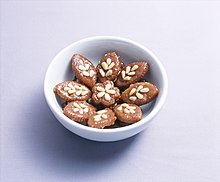Yumilgwa

Yakgwa, a variety of yumil-gwa
|
|
| Place of origin | Korea |
|---|---|
| Associated national cuisine | Korean cuisine |
| |
|
| Yumil-gwa | |
| Hangul | 유밀과 |
|---|---|
| Hanja | 油蜜菓 |
| Revised Romanization | yumil-gwa |
| McCune–Reischauer | yumil-kwa |
| IPA | [ju.mil.ɡwa] |
Yumil-gwa (유밀과; 油蜜菓) is a variety of hangwa, a traditional Korean confection. Different varieties of yumil-gwa can be made by combining a wheat flour dough with various ingredients such as: honey, cooking oil, cinnamon powder, nuts, ginger juice, jujube, and cheongju (rice wine).
The word yumil-gwa consists of three syllables: yu (유; 油) meaning "oil", mil (밀; 蜜) meaning "honey", and gwa (과; 菓) meaning "confection".
Yumil-gwa varieties have commonly been used and consumed for jesa (ancestral rites).
During the Goryeo era (918–1392), yumil-gwa were offered during national feasts, rites, ceremonies, and banquets, including two Buddhist festivals, the Lotus Lantern Festival and the Festival of the Eight Vows. In 1274, yumil-gwa varieties were used for pyebaek (formal greeting) in the wedding ceremony of King Chungnyeol and Princess Jeguk of Yuan China. In 1296, yumil-gwa was brought to the wedding ceremony of the Crown Prince Won (later King Chungseon) and Princess Gyeguk of Yuan, China.
Excessive use of yumil-gwa has led to the introduction of several regulations throughout history. In 1117, King Sukjong issued a restriction on the extravagant usage of yumil-gwa. In 1192, it was commanded that yumil-gwa had to be replaced with fruits. In 1353, a total ban was placed on yumil-gwa. During the Joseon era (1392–1897), the use of yumil-gwa was restricted solely for rites, weddings, and toasts to longevity.
...
Wikipedia
